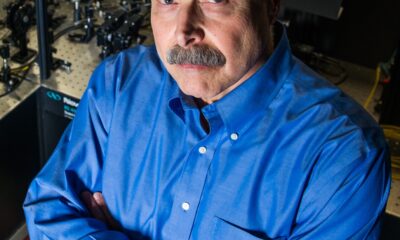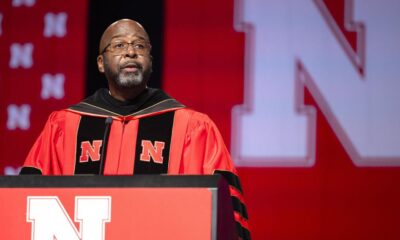Science
University of Nebraska Secures $2.5 Million for Quantum Research

The University of Nebraska–Lincoln has received a significant boost in its quantum research capabilities with a new grant of $2.5 million from the national Department of Energy’s Established Program to Stimulate Competitive Research (EPSCoR). This funding will support a seven-member research team, led by Xia Hong, a professor of physics and astronomy, in exploring the potential of ferroelectric oxides to develop advanced electronic devices that are both more powerful and energy-efficient.
The research primarily focuses on utilizing ferroelectric oxides to manipulate oxide and van der Waals materials. The aim is to achieve reversible transitions—such as switching materials from metallic to insulating states and vice versa—which were previously beyond the reach of classical physics. “The overarching goal is to use nanoscale control of ferroelectricity to induce a new state of matter,” Hong stated. This project is expected to pave the way for smaller, more efficient electronic devices.
Significant Research Developments
This latest grant marks the third substantial award for scientists associated with Nebraska’s Emergent Quantum Materials and Technologies (EQUATE) Center in recent months. Previously, a team led by Christian Binek, Paula and D.B. Varner Professor of Physics and EQUATE director, secured a $1.8 million grant from the National Science Foundation’s EPSCoR program to study innovative two-dimensional materials. Another international team, under the guidance of Evgeny Tsymbal, George Holmes Distinguished Professor of Physics, received $2 million through the NSF’s Designing Materials to Revolutionize and Engineer Our Future program.
Binek emphasized the importance of these awards, stating, “They build on the momentum created when EQUATE was established nearly five years ago with a $20 million NSF grant.” He noted that the funding will enhance research capabilities and expand expertise in quantum materials science at the university.
The two-year grant, which has the potential for renewal for up to four additional years, is designed not only to advance research but also to foster workforce development. The project, entitled “Emergent Interface Phenomena Enabled by Ferroelectric Oxide Thin Films and Membranes,” involves collaboration with the South Dakota School of Mines and Technology. It aims to support three early-career scientists: Zuocheng Zhang, assistant professor at the University of Nebraska–Lincoln; and Tula Paudel and Alexey Lipatov, assistant professors at South Dakota School of Mines.
Innovative Research Approaches
The grant focuses on three main research thrusts. The first involves investigating the interface between ferroelectric oxides and strongly correlated oxides. The goal is to achieve reversible quantum phase transitions, enabling a low-voltage control mechanism suitable for binary logic and memory devices. Instead of relying on destructive methods like high pressure, the team plans to utilize ferroelectric polarization to create a more efficient switching method.
The second thrust explores multiferroic systems that combine ferroelectricity and magnetism. By employing various doping techniques, researchers aim to convert ferroelectric insulators into polar metals. This could lead to low-energy data storage options by using electric fields to switch magnetic states within domain walls.
The third focus area is the creation of superlattices of ferroelectric domains. This approach aims to engineer new electronic and optical properties in two-dimensional van der Waals materials. By adjusting the rotation angle between oxide layers using stacking techniques, the team hopes to generate new Moiré patterns and induce novel electronic and magnetic states.
If successful, these advancements could lead to the development of innovative platforms for smartphones and other electronic devices, potentially revolutionizing the way these technologies operate while reducing energy consumption.
Reflecting on the project, Hong expressed her motivation, stating, “That’s the beauty of fundamental science—sometimes you don’t see the impact right away, but you are driven by curiosity and the fascination with how things behave.” Through this research, the University of Nebraska–Lincoln continues to position itself as a leader in the field of quantum materials science.
-

 Technology5 months ago
Technology5 months agoDiscover the Top 10 Calorie Counting Apps of 2025
-

 Health3 months ago
Health3 months agoBella Hadid Shares Health Update After Treatment for Lyme Disease
-

 Technology7 days ago
Technology7 days agoOpenAI to Implement Age Verification for ChatGPT by December 2025
-

 Health3 months ago
Health3 months agoErin Bates Shares Recovery Update Following Sepsis Complications
-

 Technology4 months ago
Technology4 months agoDiscover How to Reverse Image Search Using ChatGPT Effortlessly
-

 Technology3 months ago
Technology3 months agoElectric Moto Influencer Surronster Arrested in Tijuana
-

 Technology1 month ago
Technology1 month agoDiscover 2025’s Top GPUs for Exceptional 4K Gaming Performance
-

 Technology5 months ago
Technology5 months agoMeta Initiates $60B AI Data Center Expansion, Starting in Ohio
-

 Technology5 months ago
Technology5 months agoRecovering a Suspended TikTok Account: A Step-by-Step Guide
-

 Health3 months ago
Health3 months agoAnalysts Project Stronger Growth for Apple’s iPhone 17 Lineup
-

 Health5 months ago
Health5 months agoTested: Rab Firewall Mountain Jacket Survives Harsh Conditions
-

 Lifestyle5 months ago
Lifestyle5 months agoBelton Family Reunites After Daughter Survives Hill Country Floods





















